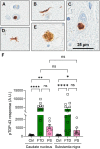TDP-43 Cryptic RNAs in Perry Syndrome: Differences across Brain Regions and TDP-43 Proteinopathies
- PMID: 39788898
- PMCID: PMC12006891
- DOI: 10.1002/mds.30104
TDP-43 Cryptic RNAs in Perry Syndrome: Differences across Brain Regions and TDP-43 Proteinopathies
Abstract
Background: Perry syndrome (PS) is a rare and fatal hereditary autosomal dominant neurodegenerative disorder caused by mutations in dynactin (DCTN1). PS brains accumulate inclusions positive for ubiquitin, transactive-response DNA-binding protein of 43 kDa (TDP-43), and to a lesser extent dynactin.
Objectives: Little is known regarding the contributions of TDP-43, an RNA binding protein that represses cryptic exon inclusion, in PS. Therefore, we sought to identify the degree of TDP-43 dysfunction in two regions of PS brains.
Methods: We evaluated the levels of insoluble pTDP-43 and TDP-43-regulated cryptic RNAs and protein in the caudate nucleus and substantia nigra of 7 PS cases, 12 cases of frontotemporal lobar degeneration (FTLD) with TDP-43 pathology, and 11 cognitively healthy controls without TDP-43 pathology.
Results: Insoluble pTDP-43 protein levels were detected in PS brains to a similar extent in the caudate nucleus and substantia nigra but lower than those in FTLD brains. The caudate nucleus of PS showed accumulation of eight TDP-43-regulated cryptic RNAs (ACTL6B, CAMK2B, STMN2, UNC13A, KCNQ2, ATG4B, GPSM2, and HDGFL2) and cryptic protein (HDGFL2) characteristic of FTLD. Conversely, only one cryptic target, UNC13A, reached significance in the substantia nigra despite similar pTDP-43 levels.
Conclusion: We detected TDP-43 cryptic RNAs and protein in PS caudate nucleus. Given the importance of cryptic exon biology in the development of biomarkers, and the identification of novel targets for therapeutic intervention, it is imperative we understand the consequences of TDP-43 dysfunction across different brain regions and determine the targets that are specific and common to TDP-43 proteinopathies. © 2025 The Author(s). Movement Disorders published by Wiley Periodicals LLC on behalf of International Parkinson and Movement Disorder Society.
Keywords: Perry syndrome; cryptic; frontotemporal dementia; frontotemporal lobar degeneration; transactive‐response DNA‐binding protein of 43 kDa (TDP‐43).
© 2025 The Author(s). Movement Disorders published by Wiley Periodicals LLC on behalf of International Parkinson and Movement Disorder Society.
Figures



Similar articles
-
Analysis of the splicing landscape of the frontal cortex in FTLD-TDP reveals subtype specific patterns and cryptic splicing.Acta Neuropathol. 2025 Jun 6;149(1):59. doi: 10.1007/s00401-025-02901-7. Acta Neuropathol. 2025. PMID: 40478310 Free PMC article.
-
Frontotemporal lobar degeneration targets brain regions linked to expression of recently evolved genes.Brain. 2024 Sep 3;147(9):3032-3047. doi: 10.1093/brain/awae205. Brain. 2024. PMID: 38940350 Free PMC article.
-
Perry Syndrome: A Distinctive Type of TDP-43 Proteinopathy.J Neuropathol Exp Neurol. 2017 Aug 1;76(8):676-682. doi: 10.1093/jnen/nlx049. J Neuropathol Exp Neurol. 2017. PMID: 28789478 Free PMC article.
-
TDP-43 as a possible biomarker for frontotemporal lobar degeneration: a systematic review of existing antibodies.Acta Neuropathol Commun. 2015 Apr 1;3:15. doi: 10.1186/s40478-015-0195-1. Acta Neuropathol Commun. 2015. PMID: 25853864 Free PMC article.
-
Frontotemporal Degeneration with Transactive Response DNA-Binding Protein Type C at the Anterior Temporal Lobe.Ann Neurol. 2023 Jul;94(1):1-12. doi: 10.1002/ana.26677. Epub 2023 May 30. Ann Neurol. 2023. PMID: 37183762 Free PMC article. Review.
Cited by
-
Large-scale RNA-Seq mining reveals ciclopirox olamine induces TDP-43 cryptic exons.Nat Commun. 2025 Jul 25;16(1):6878. doi: 10.1038/s41467-025-62004-5. Nat Commun. 2025. PMID: 40715064 Free PMC article.
-
Inhibition of nonsense-mediated decay in TDP-43 deficient neurons reveals novel cryptic exons.bioRxiv [Preprint]. 2025 Jun 29:2025.06.28.661837. doi: 10.1101/2025.06.28.661837. bioRxiv. 2025. PMID: 40667039 Free PMC article. Preprint.
-
Analysis of the splicing landscape of the frontal cortex in FTLD-TDP reveals subtype specific patterns and cryptic splicing.Acta Neuropathol. 2025 Jun 6;149(1):59. doi: 10.1007/s00401-025-02901-7. Acta Neuropathol. 2025. PMID: 40478310 Free PMC article.
References
-
- Wider C, Wszolek ZK. Rapidly progressive familial parkinsonism with central hypoventilation, depression and weight loss (Perry syndrome)—a literature review. Parkinsonism Relat Disord 2008;14:1–7. - PubMed
-
- Dulski J, Konno T, Wszolek Z. DCTN1‐related neurodegeneration. In: Adam MP, Feldman J, Mirzaa GM, et al., eds. GeneReviews((R)). Seattle (WA): University of Washington; 1993‐2024.
MeSH terms
Substances
Supplementary concepts
Grants and funding
- R35 NS097273/NS/NINDS NIH HHS/United States
- PPND Family Foundation
- R01 NS120992/NS/NINDS NIH HHS/United States
- Target ALS
- R35NS097273/GF/NIH HHS/United States
- P01 AG019724/AG/NIA NIH HHS/United States
- 90052067/Haworth Family Professorship in Neurodegenerative Diseases fund
- The Albertson Parkinson's Research Foundation
- R01 AG037491/AG/NIA NIH HHS/United States
- R01AG037491/GF/NIH HHS/United States
- U54NS123743/GF/NIH HHS/United States
- BrightFocus Foundation
- Vanier Canada Graduate Scholarship from the Canadian Institutes of Health Research
- U19AG063911/GF/NIH HHS/United States
- Robert Packard Center for ALS Research at Johns Hopkins
- RF1NS120992/GF/NIH HHS/United States
- Margaret N. and John Wilchek Family
- U54 NS123743/NS/NINDS NIH HHS/United States
- P30 AG066514/AG/NIA NIH HHS/United States
- RF1 NS120992/NS/NINDS NIH HHS/United States
LinkOut - more resources
Full Text Sources

